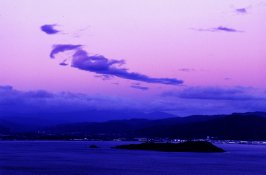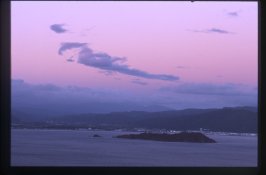@Alan:
"How do chromes look with normal lighting?" How do I describe to thee? Let me count one way: Bloody marvellous...
It's not too long after sunset (and not too long before dawn in the case of morning, and still very useable light) — about 15-20+ minutes at this time in Spring in eastern Australia, similar in NZ.
Can you show the original scan please, and start from there.
I think the baseline problem is camera exposure
and reciprocity, additional to only
moderate saturation for that film (meaning,
is it the right film for the task?), but moderate saturation might just be all you really need. How are we to know? The grain/noise appears to be interfering with detail — E100G is not this grainy, so there is noise coming from somewhere. Uncommon as it is, sometimes re-rating the film to ease off on saturation is done (e.g. EI80). But in Ray's case, there is no reference starting point image to make an informed judgement, just a very heavily modified copy. For all intents and purposes, the original may have been colourimetrically correct (I have only seen E100
GX slides, not the *G designation).
By the way, these lovely, after-sunset colours are
muted pastels, definitely not theme colours for Moulin Rouge.
The image below is straight from an RVP50 6x7 transparency (multispot metered), profiled to AdobeRGB+, USM +5% (covers scan-step loss) and straight to print (RA-4) — this and another (landscape) scene sold for $1,480.
____________________________________________________________
Sample — Earth's Shadow (blue) and Belt of Venus (pink):
20 minutes after sunset (sun down below western horizon, this is view east);
RVP50 w/ additional 6s reciprocity correction at exposure.
____________________________________________________________
View attachment 188581
It is very possible to achieve this with
any film (including E100G, even a pinhole camera) — but the more control
you have over the camera and film.




 As with exposing slides, it appears to me that there's less room for error than with negatives.
As with exposing slides, it appears to me that there's less room for error than with negatives.


 Snowset
Snowset